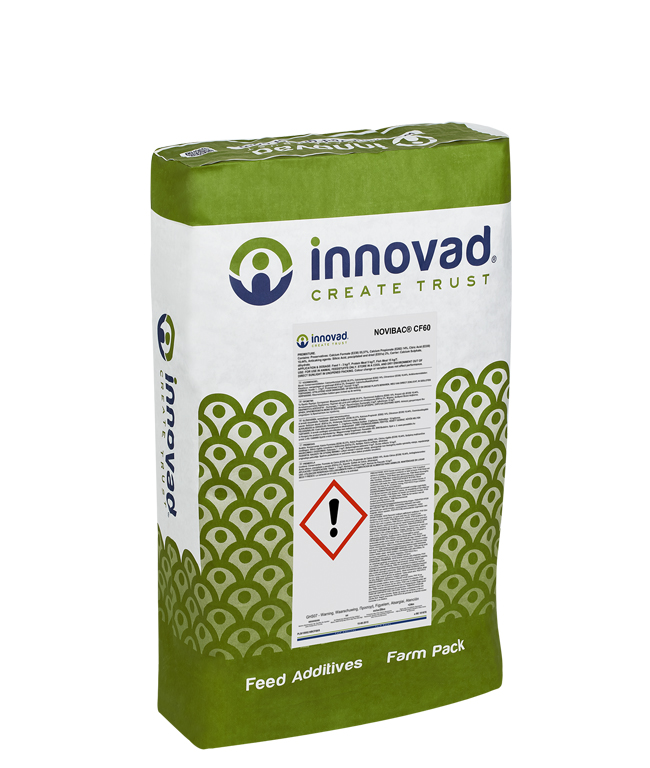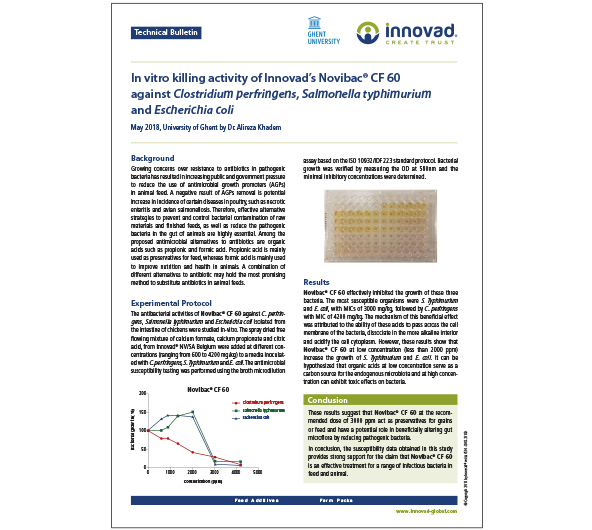ConSept® CF60
Avoid bacterial growth and control pathogens
Feed Quality
Feed quality is key to animal performance and contributes to the profitability. Both microbiological and chemical processes of the raw materials and the feed lower their nutritional value and contaminate them with hazardous molecules. Microbiological contaminants include moulds, yeasts and bacteria which lead to nutrient spoilage and production of toxic compounds. Chemical contaminants may already be present in raw materials and should be monitored closely (e.g. heavy metals, pesticides) or they may appear due to chemical reactions in the feed such as autoxidation.
Bacteria in feed: a source of pathogens for the animal
Food scandals, the ban of antibiotics and public opinion for safe food, put special focus on prevention of bacterial contamination and maintenance of feed hygiene and quality standards. The whole production chain, from raw material producers to farmers has to be involved in this ‘farm to fork’ process: safe feed is the first step to ensure safe food. Whereas feed hygiene is still the biggest determining factor on the prevalence of certain bacteria in meat, any risk of feed contamination with potentially pathogenic bacteria should be monitored and corrective actions should be taken. Besides Salmonella and E. coli, other feed borne pathogens like Listeria and Campylobacter are of high concern due to their link with antibiotic resistance.
An integral feed hygiene program should include a clear risk identification program: a list of the risks, evaluation of their severity and the likelihood for occurrence, including optimal prevention/corrective measures and monitoring.
The ConSept® product range offers carefully designed preservative concepts that contribute to a better basic feed quality, offer longer shelf life and safeguard nutritional quality and palatability. Selection is based on active components, buffered or non-buffered mixes, liquid or dry application, corrosiveness, etc. Based on know-how and experience, Innovad® can define with the customer the most appropriate product and application.
Modes of Action
Organic acids as antimicrobial agents function in two distinct ways:
- Lowering pH through the release of protons to the surrounding media which creates unfavourable conditions for pathogens, and
- The ability to interchange between their undissociated and dissociated forms, depending on the pH of the surrounding environment. An acid in its undissociated form can diffuse freely through the cell membrane of microorganisms, into the neutral pH cell cytoplasm. Once within the cell the acid undergoes a dissociation process by releasing protons that reduce the internal pH. Bacteria must maintain a near neutral cytoplasmic pH to sustain functional macromolecules. As a consequence, the pH drop suppresses cell enzymes and nutrient transport systems, causes metabolic disturbances, cytoplasmic membrane leakage and death of the pathogen. Although bacteria are capable of exporting the excess protons, this requires consumption of cellular energy which eventually results in cell death.
Unlike antibiotics the antimicrobial activity of organic acids is pH dependent. At low pH, organic acids are mainly in their undissociated form. Consequently, the antimicrobial activity of organic acids is higher at low pH.
Product composition and positioning may vary by market based on the regulatory status.

Testing the inhibiting activity of ConSept® CF60 against pathogenic bacteria
The reduction of antimicrobial growth promoters use (AGPs) in animal feed results in a potential increase in incidence of certain diseases in poultry such as necrotic enteritis and avian salmonellosis. Organic acids can provide an antimicrobial alternative to antibiotics. Dr. Alireza Khadem tested the antibacterial activities of ConSept CF60® against C. Perfringens, Salmonella and E. coli isolated from the intestine of chickens.
